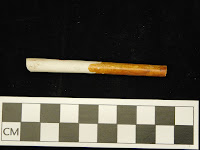Pipe Stem Dating at Strawbery Banke
Hello everyone, my name is Cassandra Trevino and I am an archaeology student currently working on my Master's degree in Applied Archaeology. For the past two weeks I have had the pleasure of volunteering at Strawbery Banke Museum. I live in Southern California, so traveling to New Hampshire for this field school has been a wonderful experience. I personally do not have much experience with historical archaeology and lab work, so having this opportunity to work at Strawbery Banke with its rich history was amazing. Most of my experience doing archaeology on the West coast is primarily prehistoric archaeology or pre-contact, so I was extremely excited to get some experience in archaeology at a historic New England seacoast site like Strawbery Banke.
 |
| Photo by David J. Murray, ClearEyePhoto.com |
I choose to study the clay pipes that were recovered during the excavation. In the collection are fragments of pipe stems and bowls.
 |
| Illustration of the parts of a tobacco pipe (Noël Hume 1969:297) |
9/64" - 1590 to 1620
8/64" - 1620 to 1650
7/64" - 1650 to 1680
6/64" - 1680 to 1720
5/64" - 1720 to 1750
4/64" - 1750 to 1800
 |
| Bar graph showing distribution of pipe stem bore diameters by count |
 |
| Pie chart showing distribution of pipe stem bore diameters by percentage |
Another way to date pipes is by looking at the stems and bowls for maker's marks. Pipe makers generally will stamp the pipe with their mark so they can get recognized for their work. They can take the form of initials or their full name. Sometimes, along with the maker's mark with the pipe maker's name, there is a mark that will also give the location of where the pipe was made.
Most of the pipes that have been recovered at the Yeaton-Walsh site were imported from Dutch and Scottish pipe makers. The decoration found on the both the pipe stems and the bowls are also a good indication of the time period and the location for the pipe. For example, most of these pipe stems have decoration that were common among Dutch pipe makers. Some of the pipe stems were also glazed so the porous clay stem would not stick to the person's lips while smoking. Below you can see some examples of pipe stems, decorated bowls, and a mended pipe that is almost complete that were found at the Yeaton-Walsh site. Enjoy!







Comments
Post a Comment